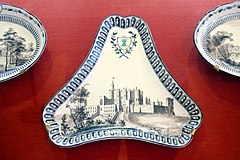Chesmensk Palace
The Tschesmensker Palace ( Russian Чесменский дворец , Tschesmensky dworez ) in neo-Gothic style on the outskirts of St. Petersburg (Uliza Gastello 15) served as an imperial travel palace on the road to Tsarskoye Selo (now Moskovsky Prospect). Together with the neighboring Tschesmensk church , it forms a unique architectural ensemble . The name recalls the Russian victory in the sea battle of Çeşme .
history
The road to Tsarskoye Selo was laid out in 1717 on swampy terrain. In 1774, Catherine II ordered the construction of a travel castle there, in order to be able to rest on the journey to the summer residence. The court architect Georg Friedrich Veldten was commissioned to complete the construction together with that of the neighboring Tschesmensk church in 1777. Models were apparently the Longford Castle built by the architect John Thorpe and the Inveraray Castle . In the central round room, the sculptor Fedot Schubin set up a portrait gallery of the Russian grand dukes and tsars from Rjurik to Elisabeth . The palace was initially called the Kekerikeksinsk Palace (from the Finnish word for frog swamp) until it was named Tschesmensker Palace in 1780 to celebrate the 10th anniversary of the victory in the naval battle of Çeşme. Already in 1770 Catherine II had the cream colored. Pottery - Service with the green frog for the Tschesmensker Palais at Josiah Wedgwood commissioned.
Catherine II often stayed in the Tschesmensker Palace. The knights of the Order of St. George used the round hall on the second floor for their meetings with the Empress. Here were awarded the highest Russian military order Mikhail Kutuzov , Alexander Suvorov and others.
After the death of Catherine II, the Tschesmensk palace was no longer used, as her successor Paul I no longer resided in Tsarskoye Selo, but in Gatchina . Paul I wanted the palace to be used as a hospital for the poor . In 1799 a special commission determined that the palace was unsuitable for the establishment of an Order of Malta hospital . The Chesmensk church was too cold for services in winter. Therefore, in December 1811, a warm winter church was set up in the Tschesmensker Palais on the ground floor of the east tower with church utensils and the travel iconostasis Alexeis I from the St. Petersburg Hermitage . After the French Russian campaign in 1812 , work began on using the Tschesmensk Palace for disabled veterans . In 1815, Nicholas I opened a poor house there, which was then named after him. In 1831–1836, the architect Alexander Staubert added two-story wings to the towers, and the winter church was moved to the round hall on the second floor. The towers received domed roofs. In 1834 the wild forest in front of the palace was transformed into a recreation park.
The poor house wasn't closed until 1919. After that, the building served as a concentration camp known as Tschesmenka . In the 1930s, the Tschesmensker Palais housed the Automobile Traffic Institute. In 1941 the Leningrad Aviation Apparatus Institute moved in . During the German-Soviet War and the Leningrad blockade , the Chesmensk Palace and the Chesmensk Church suffered greatly. The State University for Aerospace Apparatus Construction was housed in the palace, which was restored in 1946.
Web links
Individual evidence
- ↑ a b c d В. А. Фролов: [1] (accessed August 9, 2017).
- ↑ Е. А. Тартаковская: Чесменский дворец . Изобразительное искусство, Leningrad 1927.
- ↑ Н. И. Баторевич: Чесменский дворец . Белое и Черное, St. Petersburg 1997.
- ↑ Создание ЛАИ (accessed August 9, 2017).
Coordinates: 59 ° 51 ′ 24.5 ″ N , 30 ° 19 ′ 52.3 ″ E


